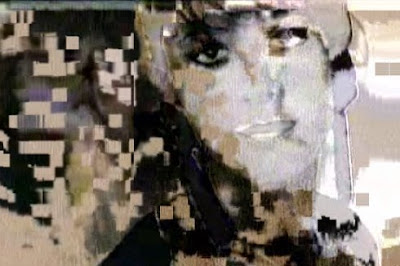A couple of months ago I was approached by a company that asked me for my knowledge on glitch and compression artifacts. They were especially interested in recreating bleeding pixels. I recognized their ideas in the work of Sven Konig and send them to his website (on which in 2005 already, Sven published a script that can be used to create such artifacts). Later the company send me an email that said they unfortunately cancelled their project.
I made my own video (and later another) though, and send it to Goto80, but in the end we also decided it seemed boring to just reuse a technique developed by somebody else - because it feels no longer as an experimental glitch, but more like an commodefied effect.
I kept track of the bleeding pixel effect and noticed its growing popularity, especially over the last few weeks. This lead me to write a small archeology of this particular compression artifact.
The bleeding pixel effect (or datamoshing) is located in a realm where compression artifacts and glitch artifacts and digital effects intertwine. The artifacts caused by compression are stable if triggered on purpose, but for the human eye quite unpredictable. Therefore, technically, they are not a glitch because the method is explainable and reproducible. They are however often perceived as a glitch (an error)- also because of their parallel existence within the realm of broken television signals and by artists used metaphorically as glitch art. The bleeding effect relies on deleting the information within one frame (the keyframe) which can be found once per 25 frames (more or less, depending on the frame rate) in a divx, xvid (or WMV) video.
I think the most interesting thing about using this effect is that it shows the materiality of digital film - it metaphorically translates the grain of the celloid to the digital pixel. Besides this, the what now has become an effect or commodity (most clearly because it has become an MTV aesthetic introduced by Kanye West), clearly lays bare the ever existing tension between what is a glitch and what is a reproducable glitch effect or commodity?
Here is a timeline. I know there are more works out there, but these works seem (for different reasons) more important or referenced too.

Sven Konig.
aPpRoPiRaTe!, 2005
Online distributed software script made to appropriate complete video files found in file sharing networks with minimal effort.
In 2007 Sven and Bitnik collaborative project Download Finished saw the light of day. Download Finished is a website that "transforms and re-publishes films from p2p networks and online archives. in Downloaf Finished, found footage becomes the rough material for the transformation machine, which translates the underlying data structure of the films onto the surface of the screen. the original images dissolve into pixels, thus making the hidden data structure visible. through Download Finished, file sharers become authors by re-interpreting their most beloved films."

Takeshi Murata
Monster Movie, 2005
Single channel digital video on DVD 4 minutes;
sound by Plate Tectonics. lo-fi version on Youtube

Paul B. Davis
(collaboration with Jacob Ciocci/PAPER RAD)
“Compression Study #2”, 2007
DVD projection (edition of 7), also on Youtube
David OReilly
Compression Reel, 2008
Vimeo Video
Data Mosher
Chairlift - "Evident Utensil" Music Video, 2009
Vimeo Video
Nabil Elderkin
KANYE WEST "Welcome To Heartbreak", 2009
Vimeo Video
Datamosher
How to Datamosh - Datamosh tutorial, February 2009.
Yung Jake
Datamosh, May 2011.
Since the release of the last three videos (by O'reilly, Chairlift and Kanye), there has been a lot of back-and-forth comment-talk on who was the first to use this effect. The Kanye video will not even be released because "there is another video out there using the same effect". Even so, most of the video makes seem to be quite nice to me and didn't get me tired of the effect yet.
Another couple of works that I really like but didnt index (due to lack of info) are by Antoine Catala and Cosmosabravo
It is only a matter of time before we will see that this artifact develops into a script, like we have seen with much praised image-glitch plugins and browsers like glitchbrowser (2005/2008) developed by dimitre, ant scott, iman moradi.
Then this enchanting artifact will be changed into just another default preset or cultivation.
Update (1): Datamosher just released a datamoshing tutorial
Update (2)(Sept 2010): Vade and Tom Butterworth have developed plugins to use this effect in VDMX and Quartz composer. UCNV created a github page that is dedicated to datamoshing avi files and Eric Souther made a MAX MSP patch.
These are just a few to choose from if you want to automate your datamosh effect!



1 comment:
Futures used compression artifacts to blend between scenes but wasn't used by the label being considered too experimental: http://www.vimeo.com/2669109
Post a Comment